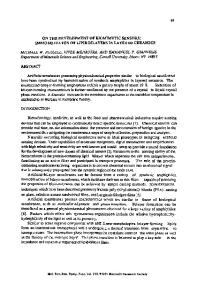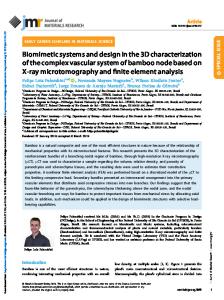Characterization of the Complex Matrix of the Mytilus Edulis Shell and the Implications for Biomimetic Ceramics
- PDF / 464,530 Bytes
- 6 Pages / 420.48 x 639 pts Page_size
- 12 Downloads / 335 Views
CHARACTERIZATION OF THE COMPLEX MATRIX OF THE MYTILUS EDULIS SHELL AND THE IMPLICATIONS FOR BIOMIMETIC CERAMICS
J.A. Keith*, S.A. Stockwell*, D.H. Ball*, W.S. Muller*, D.L. Kaplan*, T.W. Thannhauser**, R.W. Sherwood** *Biotechnology Division, US Army Natick RD&E Center, Natick, MA 01760-5020 USA "**Analytical and Synthesis Facility, Cornell University Biotechnolgy Core Facility, Ithaca, NY 14853 ABSTRACT The macromolecular matrix present in the composite shell of the blue mussel, Mytilus edulis, accounts for less than 1% of the shell by weight but is theorized to play a significant role in controlling the growth, morphology, and orientation of the CaCO 3 that makes up the shell. The presence of several proteins in this matrix, only some of which have affinity for calcium, suggests a hierarchical structural model for the shell. Proteins were isolated under denaturing, reducing conditions and separated by centrifugation, gel electrophoresis, and high performance liquid chromatography. The major matrix proteins, both soluble and insoluble, were evaluated for amino acid composition, calcium binding, and glycosylation. Some N-terminal sequence data was collected. Non-proteinaceous components of the matrix were also analyzed. Comparison of the mussel shell matrix with the protein matrix of other molluscan systems suggests that this complexity is not unique to the mussel and may provide a key to the understanding of more generic biomineralization processes necessary for such applications as biomimetic ceramics.
INTRODUCTION The formation of molluscan shell structures or composites containing calcium carbonate involves control over crystal morphology, size, density, and orientation at the molecular level that is at present unattainable synthetically. The organic portion of most mollusc shells, consisting of 0.1 to 5 % by weight of the total structure [1], is postulated to be the source of this control [2-5]. A review of the literature shows a variety of compositions and functionalities assigned to this organic portion, termed the matrix, including proteins; specifically proteoglycans [6], phenyloxidase crosslinked proteins[7], and phosphoproteins [8-10], as well as polysaccharides such as chitin [11, 12], sulfated mucopolysaccharides [ 13, 14], neutral and amino sugars [1,15], and lipids [16] . Characterization of the matrix composition varies with species of mollusc [1, 3, 17, 18] and methodology [19]. Past attempts to characterize this organic matrix have focused on a soluble proteinaceous fraction with acidic functionality which inhibits crystallization [18, 21,22], isolated mainly from Mercenariamercenaria,Crassostreavirginica,or Mytilus californianus[3, 15, 20]. To begin to determine the mechanisms involved in the biomineralization process, a complete analysis of the organic matrix of Mytilus edulis was performed. This species of mollusc was in part chosen for the complexity of the shell, which consists of an inner nacreous layer of aragonite, a pallial calcitic layer, and an outer prismatic layer of calcite [23-25]
Data Loading...











